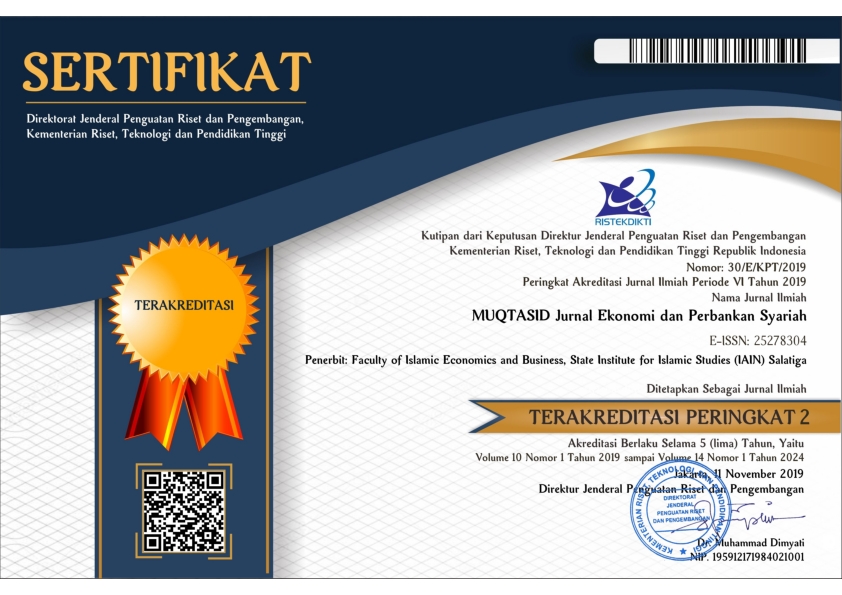Efficiency Determinant Analysis in Islamic Bank in Indonesia
Abstract
This study is aimed to discover efficiency determinant factors of Islamic banks in Indonesia to maintain financial system stability. Financial data of 11 Islamic Banks in Indonesia was obtained from 2010-2019. Purposive sampling method is employed to determine the obtained-sample with the availability of financial statements as criteria. There are two analysis data methods, firstly, Data Envelopment Analysis (DEA) is employed to calculate the efficiency score and analyze the efficiency condition of Islamic banks, and secondly multiple regression analysis which is employed to identify the determinant factors of efficiency. Based on the research model used, this study found that only the CAR and size variables were able to significantly increase the efficiency of Islamic banks. Likewise, macroeconomic variables have not been able to have any impact on the level of efficiency. Policy recommendations are also provided in the end of the discussion chapter.
Keywords
Full Text:
PDFReferences
Adami, R., Gough, O., Muradoglu, G., & Sivaprasad, S. (2010). Returns and Leverage Program. Oxford Business & Economics Conference. London.
Ahmad, N. H. & Noor, M. A. N. M. (2011). The Determinants Efficiency and Profitability of World Islamic Banks. 3. Retrieved from International Proceedings of Economics Development and Research, website: www.ipedr.com/vol3/47-M10013.pdf
Al-Delaimi, K. S. K., & Al-Ani, A. H. B. (2006). Using Data Envelopment Analysis to Measure Cost Efficiency with an Application on Islamic Banks. Scientific Journal of Administrative Development, 4, 134–156.
Ali, S. S. (2007). Financial Distress and Bank Failure: Lessons from Closure of Ihlas Finans in Turkey. Islamic Economic Studies, 4(1).
Altavilla, C., Boucinha, M., & Peydro, J. L. (2017). Monetary Policy and Bank Profitability in a Low Interest Rate Environment. Working Paper Series 2105. European Central Bank.
Aviliani, Siregar, H., Maulana, T. N. A., & Hasanah, H. (2015). The Impact of Macroeconomic Condition on the Bank's Performance In Indonesia. Buletin Ekonomi Moneter dan Perbankan, 17(4).DOI: https://doi.org/10.21098/bemp.v17i4.503.
Avkiran, N. K. (2000). Decomposing the Technical Efficiency of Trading Banks in the Deregulated Period. The University of Queensland.
Beck, T., Demirgüç-Kunt, A., & Merrouche, O. (2010). Islamic vs. Conventional Banking: Business Model, Efficiency and Stability. Journal of Banking & Finance, 37(2), 433447.
https://doi.org/10.1016/j.jbankfin.2012.09.016.
BI. (2007).Booklet Stabilitas Sistem Keuangan. Jakarta: Directorate of
Research and Regulation of Banking.
Charnes, A., Cooper, W. W., & Rhodes, E. (1978). Measuring the Efficiency of Decision Making Units. European Journal of Operation Research, 2(6), 429–440.
Combey, A., & Togbenou, A. (2017). The Bank Sector Performance and
Macroeconomics Environment: Empirical Evidence in Togo. International
Journal of Economics and Finance, 9(2). DOI:10.5539/ijef.v9n2p180.
Dabla-Noris, E., & Floerkemeir. (2007). Bank Efficiency and Market Structure: What Determines Banking Spreads in Armenia. International
Monetary Fund WP/07/134.
Firmansyah, I. (2018). Efficiency and Performance of Islamic Bank: Quadrant Analysis Approach. International Journal of Islamic Business
and Economics, 2(1), 15–25. DOI:
https://doi.org/10.28918/ijibec.v2i1.1251.
Ghassan, H. B., Fachin, S., & Guendouz, A. A. (2013). Financial Stability of Islamic and Conventional Banks in Saudi Arabia: A Time
Series Analysis. DSS Empirical Economics and Econometrics Working
Paper Series No. 2013/1. Sapienza University of Rome.
Harkati, R., Alhabshi, S. M., & Kassim, S. (2020). Competition between Conventional and Islamic Banks in Malaysia Revisited. Journal of Islamic Accounting and Business Research.
Husna, H. N., & Rahman, R. A. (2012). Financial Distress-Detection Model for Islamic Banks. International Journal of Trade, Economics and Finance, 3(3), 158.
Kalirajan, K. P., & Shand, R. T. (1999). Frontier Production Functions and Technical Efficiency Measures. Journal of Economic Surveys, 13(2), 149–172. https://doi.org/10.1111/1467-6419.00080.
King, R. G., & Levine, R. (1993). Finance and Growth: Schumpeter Might Be Right. The Quarterly Journal of Economics, 108, 717-737., 108, 717–737.
Kusmayadi, D., Firmansyah, I., & Badruzaman, J. (2017). The Impact of Macroeconomic on Non Performing Loan: Comparison Study at Conventional and Islamic Bank. Iqtishadia, 11(2), 193-216.
DOI:10.21043/iqtishadia.v10i2.2864.
Louati, S., Louhichi, A., & Boujelbene, Y. (2016). The Risk-Capital-Efficiency Trilogy: A Comparative Study between Islamic and Conventional Banks. Managerial Finance, 42(12), 1226-1252. DOI 10.1108/MF-01-2016-0009.
Lucchetti, R., Papi, L., & Zazzaro, A. (2001). Banks' Inefficiency and Economic Growth: A Micro‐Macro Approach. Scottish Journal of Political Economy, 48(4), 400–424.
Mirzaei, A., & Moore, T. (2014). What Are the Driving Forces of Bank Competition Across Different Income Groups of Countries? Journal of International Financial Markets, Institutions and Money, 32(c), 38–71.
Permana, F. Y., & Adityawarman. (2015). Analisis Faktor-Faktor yang Mempengaruhi Tingkat Efisiensi Perbankan Syariah di Indonesia. Diponegoro Journal of Accounting, 4(3).
Schinasi, G. (2006). Safeguarding of Financial Stability: Theory and Practice. Washington: International Monetary Fund.
Sufian, F. (2006). Size and Return to Scale of the Islamic Banking Industry in Malaysia: Foreign Versus Domestic Banks. IIUM Journal of Economics and Management, 14(2), 147–175.
Sufian, F., & Noor, M. A. N. M. (2009). The Determinants of Islamic Banks' Efficiency Changes: Empirical Evidence from the MENA and Asian Countries Islamic Banking Sectors. International Journal of Islamic and Middle Eastern Finance and Management, 2(2), 120-138.
Sugiarto, A. (2003). Mencari Struktur Perbankan yang Ideal. Harian Kompas (16 Juli, 2003).
Talluri, S. (2000). Data Envelopment Analysis: Models and Extensions, Decision Line, 31 (3), 8-11.
Tanjung, H., & Devi, A. (2013). Metodologi Penelitian Ekonomi Islam. Jakarta: PT Gramata Publishing.
Wahab. (2015). Analisis Faktor-Faktor Yang Mempengaruhi Efisiensi Bank Umum Syariah di Indonesia Dengan Pendekatan Two Stage Stochastic Frontier Aproach (Studi Analisis di Bank Umum Syariah). Economica, 6(2). DOI: 10.21580/economica.2015.6.2.794.
Widiarti, A. W., Siregar, H., & Andati, T. (2015). The Determinants of Bank's Efficiency in Indonesia. Buletin of Monetary Economy and Banking, 18(2). DOI: https://doi.org/10.21098/ bemp.v18i2.520.
Yakubu, Z., & Affoi, A. Y. (2014). An Analysis of Commercial Banks' Credit on Economic Growth in Nigeria. Current Research Journal of Economic Theory, 6(2), 11–15.
Yotopoulos, P. A., & Lau, L. J. (1973). A Test for Relative Economic Efficiency: Some Further Results. The American Economic Review, 63(1), 214–223.
DOI: https://doi.org/10.18326/muqtasid.v11i2.104-116
Refbacks
- There are currently no refbacks.

MUQTASID by http://muqtasid.iainsalatiga.ac.id/ is licensed under a Creative Commons Attribution-ShareAlike 4.0 International License.
MUQTASID Jurnal Ekonomi dan Perbankan Syariah UIN SALATIGA p-ISSN: 2087-7013, e-ISSN: 2527-8304




